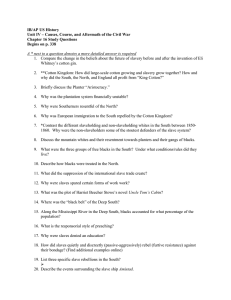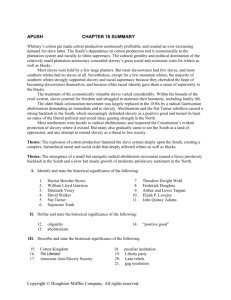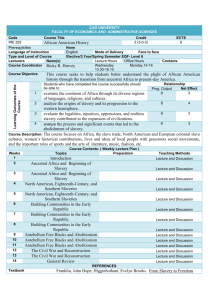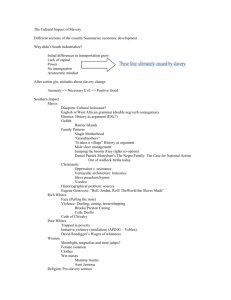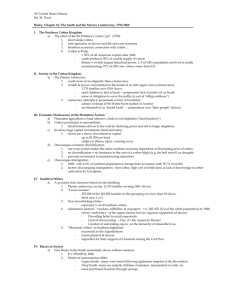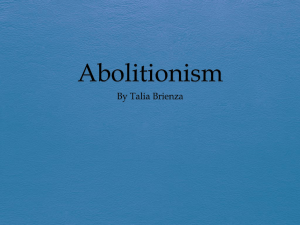File
advertisement
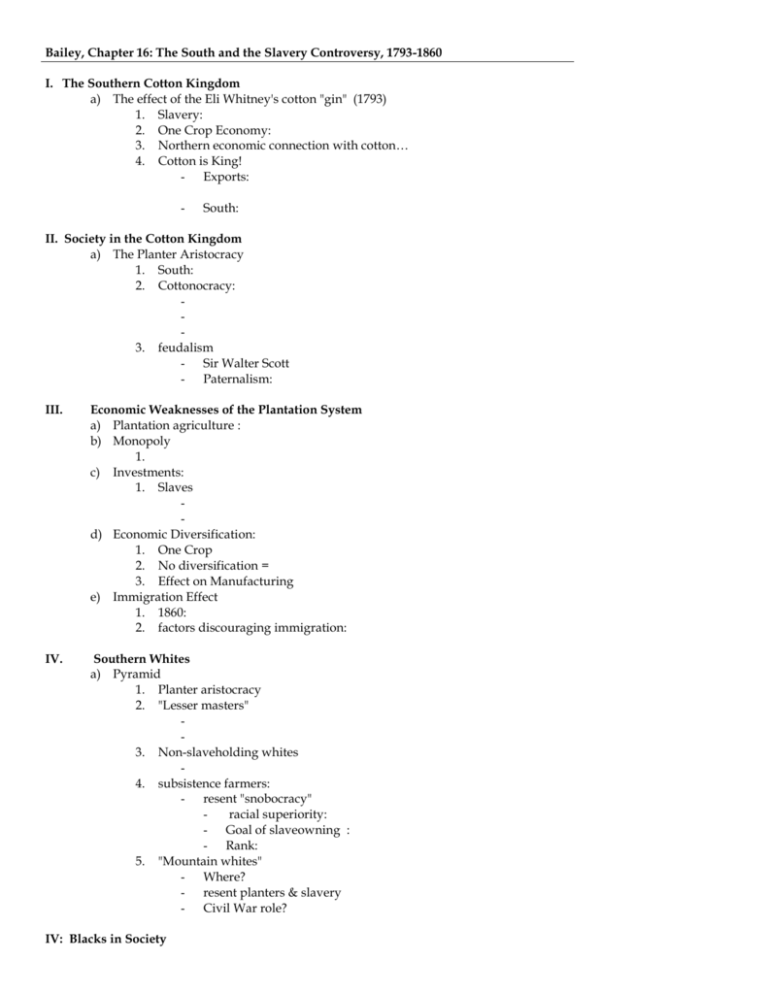
Bailey, Chapter 16: The South and the Slavery Controversy, 1793-1860 I. The Southern Cotton Kingdom a) The effect of the Eli Whitney's cotton "gin" (1793) 1. Slavery: 2. One Crop Economy: 3. Northern economic connection with cotton… 4. Cotton is King! - Exports: - South: II. Society in the Cotton Kingdom a) The Planter Aristocracy 1. South: 2. Cottonocracy: 3. feudalism - Sir Walter Scott - Paternalism: III. Economic Weaknesses of the Plantation System a) Plantation agriculture : b) Monopoly 1. c) Investments: 1. Slaves d) Economic Diversification: 1. One Crop 2. No diversification = 3. Effect on Manufacturing e) Immigration Effect 1. 1860: 2. factors discouraging immigration: IV. Southern Whites a) Pyramid 1. Planter aristocracy 2. "Lesser masters" 3. Non-slaveholding whites 4. subsistence farmers: - resent "snobocracy" racial superiority: - Goal of slaveowning : - Rank: 5. "Mountain whites" - Where? - resent planters & slavery - Civil War role? IV: Blacks in Society a) Free blacks in the South 1. # = 2. Manumission: - Upper South: - Deep South: - Purchased: - Some black slave-owners: 3. Status in Southern society - “third race” - Cannot testify v. whites in court, barred from certain occupations, vulnerable to reenslavement (must carry papers, etc.) b) Free blacks in north 1. #'s = 2. racial segregation - barred from: - conflicts with Irish immigrants 3. The irony of the North-South dialectic - Contact with blacks: - Southern mentality about blacks: Northern mentality about blacks: b) Plantation Slaves 1. #'s - legal importation ends 2. Slaves are regarded as investments by most planters: - $2 billion … - price of slaves … 4. The "black belt" - the black belt = - population majority: 5. slave breeding - explain: - "being sold down the river" -c) Life under slavery 1. Conditions vary greatly, but certain commonalities: - work from "kin to kint" - literacy - civil/political rights - whippings - paternalism v. authoritarianism 2. Effect of slavery on black families - Marriages - Families - "selling downriver" -3. Maintenance of culture under slavery - Households form, especially on larger plantations in the deep south - Maintain continuity of family identity - Oral traditions/skills passed - Christianity = a mix of Christian and African forms - Focus on the liberating messages of Christian theology - "responsorial" style of worship = d) Forms of black resistance 1. 2. 3. 4. - Gabriel Prosser Conspiracy 1800 - Denmark Vessey Conspiracy 1822 Nat Turner's Rebellion 1831 V: Abolitionism a) Early Abolitionism -- the Colonization Mov't 1. American Colonization Society (1817) b) Abolitionism in the 1830s 1. Influences 2. Theodore Dwight Weld and the "Lane Rebels" - Rev. Lyman Beecher - Weld expelled for … - American Slavery As It Is (1839) c) Radical Abolitionism 1. William Lloyd Garrison 2. American Anti-Slavery Society (1833) 3. Wendell Phillips, abolition's "golden trumpet" d) Black Abolitionists 1. David Walker : 2. Frederick Douglass : - depicts his life under slavery (son of a slave woman and a white father) - teaches himself to read and write, and escapes to the north e) Slavery in American politics 1. Abolitionists back a series of political parties 1840 1848 1852 VI: The Slave Empire Strikes Back a) Events securing southern support of slavery: 1. (1831-32) 2. (1831) 3. (1832) b) Proslavery efforts to defend the "peculiar institution" 1. "Christianity and civilization" argument 2. defense of master-slave relationship as father-child relationship 3. myth of the happy slave v c) Government crackdowns on free speech 1. 1836 -2. 1835 -- response to rioting in South Carolina where a mob burns abolitionist propaganda in the mails VII: Northern Reaction to Abolitionists a) Most treat abolitionists as radicals: 1. northern economic interest in Dixie is significant b) violence versus abolitionists 1. Lewis Tappan's house ransacked in 2. Broadcloth Mob drags Garrison through the Boston streets in 3. Rev. Elijah P. Lovejoy killed in Alton, Illinois in
